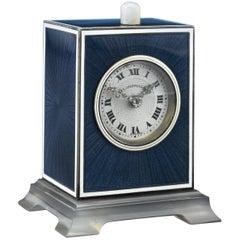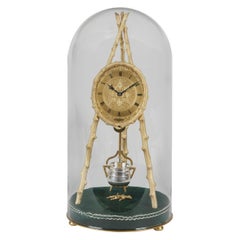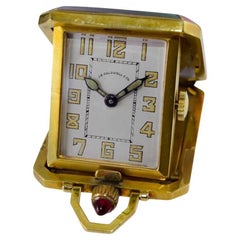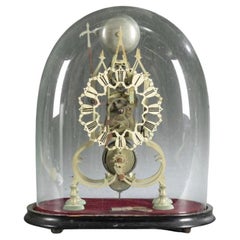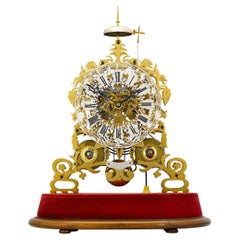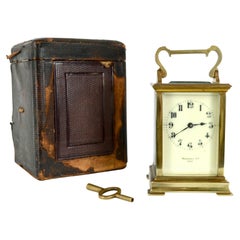Velvet Table Clocks and Desk Clocks
2
to
1
1
2
2
2
1
1
1
Height
to
Width
to
10,465
1,119
453
328
301
1
1
1
1
1
1
Material: Velvet
Art Deco J.E. Caldwell Table Clock
Located in New Orleans, LA
This luxurious and rare table clock is the essence of Art Deco style. Retailed at the renowned J. E. Caldwell & Co., this exceptional timepiece is comprised of a French clock movement...
Category
20th Century American Art Deco Velvet Table Clocks and Desk Clocks
Materials
Enamel
Early Tripod Table Clock by Thomas Cole with Glass Dome
Located in London, GB
An extraordinary rustic tripod table clock
by Thomas Cole
Retailed by E. White of London
The circular green velvet-clad base supporting three equidistantly spaced brass imitation logs, from which the clock and its mechanism are suspended; housed within a brass bezel conformingly styled as naturalistic logs, the circular etched and engraved gilt dial with elegant blued steel hands, marked at 6 o'clock "E. White, 20 Cockspur St, London", having the hours marked in Roman numerals; the tapered two-tier movement has a six wheel train with five-spoke crossings between spotted plates, the upper section fixed by blued steel screws to the backplate, enclosing a Brocot-style deadbeat escapement incorporating rubies and train to the centre wheel, the pendulum of most unusual design styled as a lidded cauldron over a simulated fire. Complete with a glass dome and key. The front plate numbered “1637.”
London made, circa 1861
Thomas Cole, (1800-1864)
Son of Thomas Cole Snr, a Somerset clockmaker, his history and works are fully recorded in 'Thomas Cole & Victorian Clockmaking' by John B. Hawkins, published 1975, in Sydney. Known as a specialist in making decorative timepieces of the highest quality, Cole exhibited at the Great Exhibition at the Crystal Palace in 1851; he warranted an 'honourable mention' in the Paris Exhibition of 1855 and the London 1862 Exposition International, where he was awarded a medal for 'excellence of taste and design'.
Hawkins discuss Thomas Cole's tripod clocks...
Category
19th Century English Antique Velvet Table Clocks and Desk Clocks
Materials
Brass, Ormolu, Bronze
Related Items
J.E. Caldwell by Mimo Deco Asian Themed Enameled Pocket Desk Clock circa 1930's
Located in Long Beach, CA
FACTORY / HOUSE: Mimo for J. E. Caldwell
STYLE / REFERENCE: Art Deco Pocket Desk Clock
METAL / MATERIAL: 14kt Yellow Gold and Kiln Fired Enamel
CIRCA / YEAR: 1930's
DIMENSIONS / SI...
Category
1930s Swiss Art Deco Vintage Velvet Table Clocks and Desk Clocks
Materials
Gold, Enamel
H 16.15 in Dm 12.6 in
Early 19th Century, Gothic Brass Skeleton Clock on Wood Base with Glass Dome
Located in Middleburg, VA
Early 19th century Gothic brass skeleton clock on wood base with glass dome. Bell on peak with steeple design and halberd hammer. Painted metal fa...
Category
Early 19th Century English Gothic Antique Velvet Table Clocks and Desk Clocks
Materials
Brass
H 16 in W 13.5 in D 7.25 in
Art Deco Table Desk Clock Kienzle
Located in Vienna, AT
Brass frame nickel plated clock face made of polished steel and fixed on pink colored glass made by Kienzl in the late, 1930s. Fitted with a mechanical movement. On request can be re...
Category
1930s German Industrial Vintage Velvet Table Clocks and Desk Clocks
Materials
Ceramic
Seth Thomas Antique Mantel Clock
Located in Hamilton, Ontario
Ornate gilded brass cased mantel clock by Seth Thomas. Recently serviced and working. It has an 8-day time and strike movement with a mercury pendulum...
Category
Early 20th Century American Velvet Table Clocks and Desk Clocks
Materials
Enamel, Brass
Art Deco ATO Mantel Clock
By ATO
Located in Norwich, GB
Art deco ATO clock standing on a three tiered Bakelite base supporting a glass dial with Art Deco style chrome numerals and chrome chapter ring.
The movement is powered by a 1.5...
Category
1920s French Art Deco Vintage Velvet Table Clocks and Desk Clocks
Materials
Chrome
French Bulle Electric Clock Swedish Cut Crystal Glass Dome
Located in Vienna, AT
Patented by Maurice Favre-Bulle in 1920.
Battery-operated brass movement, dial with Arabic numerals with the inscription Bulle Patent, blackened wooden base with plaque underneath. G...
Category
1930s French Art Deco Vintage Velvet Table Clocks and Desk Clocks
Materials
Crystal, Brass
Table clock, French Art Deco, Panther
Located in Monza, IT
Table clock, French Art Deco, Panther
Elegant table clock, 1920s-1930s, French Art Deco, made of marble and bronze, Girardot Chateaudun brand.
In good condition, as shown in the phot...
Category
Early 20th Century French Art Deco Velvet Table Clocks and Desk Clocks
Materials
Marble, Bronze
Art Deco Mantel Clock
Located in Vienna, AT
Original condition, perfect working
Softwood covered with nutveneer
attributed to Kienze
Category
1920s Austrian Art Deco Vintage Velvet Table Clocks and Desk Clocks
Materials
Nutwood, Softwood
Art Deco Table Clock
Located in Buenos Aires, Argentina
Art Deco table clock
Materials: Shagreen and bronze
French Origin Circa 1920
In the center it has an original painting (Scene voyyer)
Mark on ...
Category
1920s French Art Deco Vintage Velvet Table Clocks and Desk Clocks
Materials
Bronze
Impressive Seth Thomas Antique Mantel Clock
Located in Hopewell, NJ
Handsome antique seth Thomas Mantel clock
Handsome large Seth Thomas iron black mantel clock with open escapement. Clock is in fine cond...
Category
19th Century American Antique Velvet Table Clocks and Desk Clocks
Materials
Iron
Art Deco Bakelite Telechron Clock
By Paul Frankl
Located in Chicago, IL
Beautiful Period Art Deco Bakelite Telechron Clock in the manner of Paul Frankl
As Found Condition. Missing the glass lens. the metal piece in front is ...
Category
Early 20th Century American Art Deco Velvet Table Clocks and Desk Clocks
Materials
Bakelite
Mantel Clock with a Glass Dome, circa 1930s
Located in Opole, PL
A clock with a glass shade, circa 1930, on a wooden base.
The striking, metal casing of the clock is decorated with hunting emblems, and is crowned with a semi-plastic figure of a h...
Category
1930s French Vintage Velvet Table Clocks and Desk Clocks
Materials
Metal
Previously Available Items
Royal Pavilion Skeleton Clock by Smith & Sons
Located in New Orleans, LA
A spectacular feat of engineering and artistry, this 19th-century skeleton clock was created by John Smith & Sons of Clerkenwell. The Clerkenwell Borough of Central London has for almost two centuries been one of the leading centers of clockmaking in England, and J. Smith & Sons was the region's most important skeleton clock craftsman. Smith & Sons' creations are desirable for both their appealing design and mechanical ingenuity, and their elaborate skeleton clocks are particularly prized.
Skeleton clocks are defined by their lack of an external case, revealing the intricacy and beauty of their complex internal workings. This timepiece’s mechanics are on full display, allowing one to marvel at the technical craftsmanship of the two-train movement and the desirable English dead beat escapement. The ornate, Gothic-inspired design of the present clock is composed of a hand-crafted bronze and brass skeleton frame in the shape of the famous Royal Pavilion...
Category
19th Century English Antique Velvet Table Clocks and Desk Clocks
Materials
Brass, Bronze
French Couaillet Freres Carriage Clock of Saint-Nicolas-D'Aliermont, Russell's
By Couaillet Freres
Located in Soquel, CA
A wonderful late 19th-century brass carriage clock with it's carrying case and winding key sold by Russell's Ltd. (England/France, founded 1848), c.1890s. Signed on the dial "Russell's Ltd. Paris". A great example of a French Couaillet Freres Carriage Clock of Saint-Nicolas-D'Aliermont manufacture, France. Clock isn't marked with the makers name but has the distinctive arrow design he used above the winding post.
The clock is a fine example of the corniche style, with clean brass lines framing glass panels on the sides, rear, and top, and a brass carrying handle. The internal movement is revealed and can be seen from all angles through the glass. The back panel door can be opened for access. The clock has one jewel and has been cleaned in the past, but would benefit from an additional cleaning. It keeps time but please note there is some minor variability. Clock; 5"H x 3 3/8"W x 3"D. Case, 6 3/8" x 4.5"W 4.5"D (case is well worn with significant losses to leather covering as pictured).
The period carrying case has a dark brown leather exterior and a deep purple velvet interior. The top latch is opened with a push button on the right side. The front panel of the case can be switched out for either a leather panel, or a glass panel to view the clock while it is inside. Whichever panel is not in use can be stored in a slot in the rear side. There is also a special storage slot next to the hinge for the winding key. Russel's Ltd, Paris purveyors: Following the deaths of Thomas Robert and Alfred Holgate, Alfred's son Bernard Holgate Russell and his cousin Thos Townsend Russell took over the company and the name of the business was changed in 1894 to Russells Limited. From this date it appears that they continued as retail jewellers with several branches in Liverpool and, by the early 1900's, Manchester and Llandudno as well. Clock maker: Armand Couaillet (1865–1954) was a French clock maker from Saint-Nicolas-d'Aliermont in Normandy .
In 1890 Couaillet started a business producing carriage clocks; shortly afterwards his three brothers join the business. By the turn of the century, the company employed about 100 workers and were producing 4000 carriage clocks each month.
On the eve of World War I , The Couaillet brothers employed 300 people and their catalog listed 250 models of clocks, but during the war, the focus of production switched to precision mechanical components for fuses, parts for aircraft engines and field telegraph systems.
History of Russell's Ltd:
Thomas Russell 's name is synonymous with the Lancashire watch making industry and he is an icon for watch purists and enthusiasts around the world. But how he came to become a watchmaker and why Lancashire played such an important role in the watchmaking industry is a fascinating story.
In the 17th century farmers and agricultural workers who needed to supplement their income during the winter months undertook much of the work of watchmaking. In and around Lancashire this was particularly important and the proximity of metalworking, the availability of fine metal tools and the port of Liverpool aided the growth of the industry. By the 18th century watch parts were being sub-contracted to small farms and cottages throughout the region.
Another factor in the growth of this cottage industry were the significant lower overheads that the farmers enjoyed as part-time workers in their own homes. Elsewhere wages were the largest contributor to the total cost of watch manufacturing with the cost of raw materials, apart from gold and silver used in the making of expensive cases, relatively small.
One commentator notes that, "From Prescott to Liverpool, eight miles as the crow flies, the countryside was dotted with the cottages of spring makers, wheel cutters, chain makers, case makers, dial makers - every speciality that went into the making of a watch." By the end of the 18th century between 150,000 and 200,000 watches a year were being produced by this system, satisfying the national need for accurate timekeeping as the industrial revolution took hold.
The Lancashire sub-contracting system allowed the production of watch movements at such low prices that by the end of the 18th century, the Lancashire manufacturers were supplying most of the great watch firms in London, Coventry and Liverpool. All that these firms needed to do was to make or source their own case and dial, and then assemble the watch.
Thomas Russell joined this hive of activity in 1848 when he moved his business as a watch manufacturer to Slater Street in Liverpool. The city was a major seafaring port and the manufacture of ships' clocks and chronometers became an important revenue stream for the business.
Thomas Russell's father, also named Thomas Russell (1780-1830), the founder of this watchmaking dynasty, was born in Eskdale a small village in Cumberland. He served his time in watchmaking in New St. Broughton-in-Furness Lancashire under William Bellman, he then served his journeyman time with William Wakefield in Market St Lancaster where he later started a business of his own in the same street.
He had two sons; one named Thomas was married to Mary in 1831. They also had two sons, Thomas Robert (1833-1894) born in Lancaster and Alfred Holgate Russell (1840-1893). In about 1840 the family moved to Halifax setting up a watchmaking business in Lord St. It was here that Alfred was born.
By 1848 the family had moved once more and records show that Thomas Russell was a watch manufacturer with premises at 20 or 22 Slater Street, Liverpool and later at number 32 in the same street. It was here that Thomas Russell became arguably Liverpool 's finest watchmaker and the business produced quality watches and clocks, including the celebrated Russell Hunter pocket watch. Thomas Senior and his oldest son Thomas Robert were granted a Royal Warrant by Queen Victoria indicating their rapid progress in watch manufacturing.
Around 1859, Thomas handed...
Category
Late 19th Century French Victorian Antique Velvet Table Clocks and Desk Clocks
Materials
Brass
H 5 in W 3.38 in D 3 in
Swedish Rococo Table Clock Signed by Augustin Bourdillon
Located in Mjöhult, SE
A fine Swedish 18th century rococo ringtone table clock with gilt bronze signed by Augustin Bourdillon. Covered in the original velvet with great patination. The interior of the case...
Category
18th Century European Rococo Antique Velvet Table Clocks and Desk Clocks
Materials
Bronze
English Arabesque Skeleton Clock by Evans of Handsworth
By William F. Evans of Handsworth
Located in New Orleans, LA
This incredible arabesque skeleton clock is a stellar example by the preeminent English firm of William Frederick Evans of Handsworth, Birmingham. This horologic masterpiece is in complete, working condition, boasting an amazing brass triple-layer frame, a characteristic found in the most attractive and important Evans arabesque timepieces. Not only is this clock visually stunning, but it is also a mechanical triumph with its chain fusée movement. Time is told by blued steel hands on a pierced, engraved and silvered chapter ring. Set upon its velvet-covered and plinth beneath its original glass dome, this magnificent clock is a work of true distinction.
Skeleton clocks are among the most exceptional and intriguing timepieces ever made and were designed to display as much of the working mechanism as possible. Often the result of the highest quality workmanship, skeleton clocks are actually some of the earliest clocks, some dating from the mid 16th Century as drum clocks. Popularized circa 1750 by the French, who produced wonderful spring driven antique mantle clocks...
Category
19th Century English Other Antique Velvet Table Clocks and Desk Clocks
Materials
Brass
19th Century Victorian Silver Heart Shaped Table Clock
Located in London, GB
This exquisite table clock is cast in silver and is heart shaped, and features delicate silverwork in the form of foliage and scrolls to the frame. The central, circular clock dial f...
Category
Late 19th Century English Late Victorian Antique Velvet Table Clocks and Desk Clocks
Materials
Silver
Recently Viewed
View AllMore Ways To Browse
Antique Clock Box
Bell Pull
Jaeger Lecoultre Vintage Clocks
Vintage Clock Photo
Vintage Clock Photos
Retro Light Clock
Vintage Time Clock
Mantel Desk Clocks
8 Day Desk Clock
Small Decorative Table Clock
Table Clock4
Large Desk Clocks
Mirror Vintage Mirror Mirrors Clocks
Mid Century Clock Lighted
Vintage Wood Table Clock
Antique Brass Fish
White Vintage Table Clock
Antique White Table Clock
